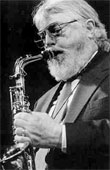|
Jazz Profiles from NPR
Bud Shank
Produced by Bruce Talbot

|
|
Alto sax player Bud Shank's melodic sound resonates with his unwavering commitment to self-expression. Throughout his lengthy career, Shank has studiously avoided compromising his musical identity for the sake of the latest trend. Though a rhythmic player, Shank's primary focus is on melody.
|
 |
Listen to composer Johnny Mandel, jazz journalist Doug Ramsey, pianist Mike Wofford, and trombonist Milt Bernhart talk about Bud's playing
|
Bud began playing clarinet at the age of ten while growing up in the small town of Vandalia, Ohio, a choice he attributes to hearing Benny Goodman and Artie Shaw on his family radio. By college, Shank had picked up the sax and was playing for a swing band at University of North Carolina. Though once billed as "Coleman Hawkins of the South," Shank had a smoother, lighter sound closer to that of the great Lester Young.
 |
Listen to Bud reflect on being hailed as the "Coleman Hawkins of the South"
|
Shank's ability to swing has made him a sought-after sideman by great band leaders ever since Charlie Barnet first auditioned the young sax player for his orchestra in 1946. A versatile stylist, Shank would also be get a coveted invitation to join the Duke Ellington Orchestra after working with the Duke on a film soundtrack in the 1970s. Shank had to reluctantly decline Duke's offer due to other commitments.
 |
Listen to Bud recall trying out for Charlie Barnet's Big Band
|
|
"He (Charlie Barnet) introduced me to Bud, who struck me as the shyest person I ever met in my life. He hardly could respond, so I talked to him at length -- but I did all the talking!"
|
|
-- Trombonist Milt Bernhart
|
When the Barnet band broke up in 1948, Bud landed a job with Stan Kenton's prestigious Innovations in Modern Music Orchestra on both lead alto sax and flute. Only 23, Shank was given responsibility for organizing the sax section, which, he says, "was an education all by itself." Shank displayed solid range, often soloing on sax alongside Art Pepper, while at other times developing as a flutist on Kenton's complex arrangements.
 |
Listen to Bud talk about his experience with Stan Kenton's Innovations in Modern Music Orchestra
|
During the 1950s, Shank became a recognized figure of the West Coast jazz scene playing in clubs like the Lighthouse, the famous Los Angeles counterpart to New York's Birdland. The Lighthouse's reputation for showcasing hip young players brought it international renown, and opened doors for Bud as well.

|
|
Shank signed a contract with Pacific Records and formed his own group with pianist Claude Williamson. They toured the US and were later joined by tenor saxophonist Bob Cooper and singer June Christy (left) on a successful tour of Europe. |
The group's success would soon be tempered as rock and roll music began to draw audiences away from the jazz scene. Versatile and resourceful as always, Shank found ample studio work on soundtracks for Hollywood films.
 |
Listen to Bud recall the jazz climate in the 1960s
|
In the late '70s, a revitalized jazz scene saw Shank emerge with a new quartet, LA 4, which included guitarist Laurindo Almeida and bassist Ray Brown. Shank also continued his long working relationship with pianist Mike Wofford, bassist Bob Magnusson and drummer Joe LaBarbera. Always exploring new musical frontiers, Shank has also played with Indian sitar maestro Ravi Shankar, Japanese kotoist Kimio Eto, and London's Royal Philharmonic Orchestra.

|
|
Shank has influenced many current and future greats with his robust technique and clean sound, developed in his early days on the horn and even better with age. He's never quiet about a musician's need to constantly develop as an artist, conveying this message to younger players through his own jazz workshop and jazz festivals. Bud remains a consummate musician whose skill and dedication to continue to make a significant contribution to jazz.
|
 |
Listen to Bud reflect on his long musical career
|
|